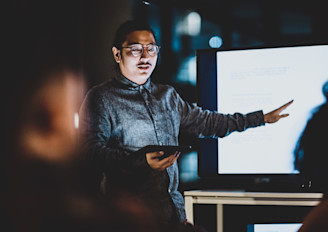
When “doing data differently” means finding inspiration in fashion

Collections are the backbone of a fashion house—designers use elements like color, shape, pattern and proportion to create a cohesive line that is recognizably and unmistakably their own. And while the runways of Paris and New York might seem a universe apart from the world of data and analytics, a team at 84.51° has been finding inspiration in the fashion realm as we embark on a journey without precedent in our practice: to build a data storytelling design system.
The goal of this system is to create a consistent pattern of narratives for data storytelling across 84.51° so that customers know what to expect anytime they interact with 84.51°’s Insights. To get there, we knew we’d have to think big and a bit unconventionally. And that realization led us to spend part of 2021 delving into Fashion Week coverage for insights from a different design perspective.
Here are insights we’ve collected along the journey—including several learnings from our foray into fashion—as we live up to 84.51°’s commitment to rethink the way we do data in order to make lives easier.
Designing for the masses
Much of the social media chatter around Fashion Week last year concerned a shift in the fashion world to designing for the masses. And a similar shift is happening in data visualization. In recent years, people have grown increasingly accustomed to interacting with data and charts in everyday interfaces, from home energy reports to fitness apps. Then the arrival of COVID-19 took it to a new level, with charts relaying the rate of spread, vaccinations and other critical metrics dominating the news and conversations.
As more complex data visualization and insights move from the world of analysts to any screen, how do we keep up with evolving expectations? The end users of 84.51° products are predominantly category product managers. They work with data on a regular basis but when it comes to data visualization tools, some may be highly savvy while others have little experience beyond Excel. The design system we develop will need to address the needs of users across a wide range of technical aptitude and preferences.
Think simple—not simplistic
For too long in data visualization we’ve been taught to design for short attention spans. Executives want an answer in minutes, but the most valuable insights can be complex and by oversimplifying the answer we too often miss the gem in the weeds. We need to shift our mindset from designing charts that can be quickly read to designing charts that make complex concepts easily understandable—without the need for a PhD. That’s where the magic is.
Designing for inclusivity—including the sight impaired
Historically, fashion design has focused on a very exclusive range of body shapes. But a growing social movement around body inclusivity has influenced designers to create clothing that not only fits different body shapes but is designed to capture the unique beauty of those shapes.
The data visualization world is starting to examine its own inclusivity issues
How do we innovate so that people of different abilities can fully access what we create, rather than look to meet the baseline requirements of ADA checklists? As we develop our 84.51° design system, we’re assessing the full range of “shapes” that we need to design for if the system is to be truly accessible. Once we’ve identified those and understand what makes each unique and powerful, we can think about how to design for them. Among the more exciting—if ambitious—possibilities (because sometimes “doing data differently” requires dreaming big): building in a data sonification algorithm that would make our tools accessible to people who are blind.
The design process
As more design-oriented thinkers come to data visualization, they’re bringing tools from the design world with them. What’s new is that we’re also now seeing data-oriented individuals start to pick up design skills and adopt design tools. Recognizing that a unique end product requires a unique process, our team has adopted three tools from the fashion industry. Mood boards, for one, are used by fashion designers to create a visual summary (think collage), of images, objects and any other elements inspiring their collection. Likewise, we’re using mood boards to keep our vision focused and consistent as we develop our design system. The exploration files our team uses to iterate on ideas also have an equivalent in the fashion world—the Illustration board, which designers use to brainstorm their ideas on paper or digitally before they cut and sew the actual clothing. And our prototypes and usability tests are analogous to the fashion industry’s client board.
A new research model
The design world isn’t the only outside realm spurring innovation in data visualization. Understanding the needs of our users requires innovative research methods, and anthropology offers a method known as ethnography to generate deeper insights within context. Ethnographies, however, can take months or years—a luxury our team doesn’t have—but the potential value of those insights was so great that we developed our own research practice: the ethnography sprint model. It involves embedding a team member in an end user’s team to begin to understand firsthand how they work, how they communicate and their unique pressures and constraints. Actively participating in that team’s work gives us the opportunity to not only observe and measure, but to experience and feel their deadline. This has allowed us to capture deep, qualitative data rich with meaning—in some cases in as little as two weeks.
Design standards that span disciplines
Our Fashion Week researched also revealed several commonalities in design standards between the worlds of fashion, graphic design and data visualization. Among them:
Aesthetics are functional. “Decoration” is a bad word in data visualization; the data:ink ratio philosophy has conditioned us to see anything that isn’t communicating the data as decorative and therefore undesirable. But in reality, aesthetics are functional. They can emphasize. They can guide attention. They can even influence how data is interpreted. Used right, decoration enhances engagement while still enabling proper interpretation.
The power of minimal color. Monochrome is a big fashion trend now and most of what we saw on the Fashion Week runways were white and/or black with just strategic splashes of color. And while minimal color use is a longstanding best practice in data visualization, the current trend takes it to an entirely new level. Consider the impact of one purple bar on an otherwise black-and-white dashboard, drawing attention to the insight users need to pay attention to most. That’s power.
Think layers. Because they work in 3D and with fabrics, fashion designers use physical space, texture, color and more to create contrast between layers. In data visualization, we talk about employing contrast for better legibility, but not enough about using layers and dimension to make data “pop.”
In the words of legendary fashion editor Diana Vreeland, “You can even see the approaching of a revolution in clothes.” Along the journey to build 84.51°’s design system, our team has gained tools that transform the possibilities of how we present and interpret data moving forward. And as we continue to look for inspiration, we’ll be monitoring the buzz around New York Fashion Week this February once again. Vive la revolution!
Visit our knowledge hub
See what you can learn from our latest posts.

